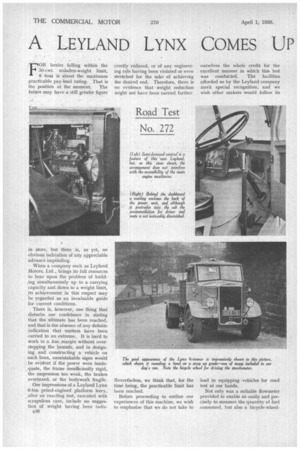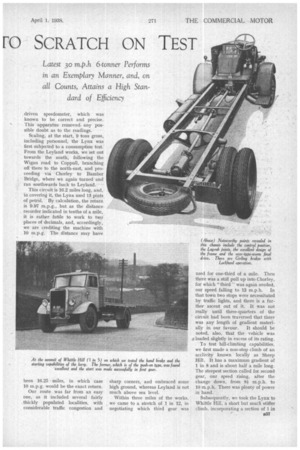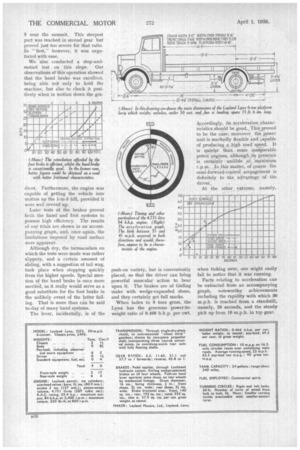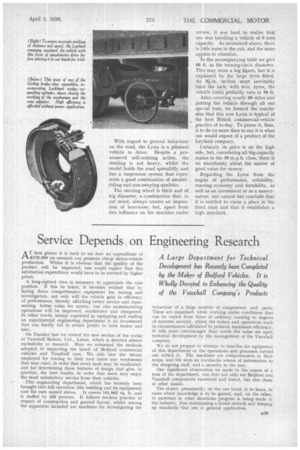A LEYLAND LYNX COMES UP 10 SCRATCH ON TEST
Page 50

Page 51

Page 52

Page 53

If you've noticed an error in this article please click here to report it so we can fix it.
Latest 30 m.p.h 6-tonner Performs in an Exemplary Manner, and, on all Counts, Attains a High Standard of Efficiency
OR lorries falling within the 50-cwt. unladen-weight limit, 6 tons " is about the maximum practicable pay-load rating. That is the position at the moment. The future may have a still greater figure
in store, but there is, as yet, no Obvious indication of any appreciable advance impending.
When a company such as Leyland Motors, Ltd., brings its full resources to bear upon the problem of build,ing simultaneously up to a carrying capacity and down to a weight limit, its achievement in this respect may be regarded as an invaluable guide for current conditions."
There is, however, one thing that disturbs our confidence in stating that the ultimate has been reached, and that is the absence of any definite indication that matters have been Carried to an extreme. It is hard to Work to a fine margin without overstepping the bounds, and in designing and constructing a vehicle on such lines, unmistakable signs would be evident if the power were made
the frame insufficiently rigid, the suspension too weak, the brakes overtaxed, or the bodywork fragile.
Our impressions of a Leyland Lynx 6-ton petrol-engined platform lorry, after an exacting test, executed with scrupulous care, include no suggestion of weight having been indis r.:16 creetly reduced, or of any engineering rule having been violated or even stretched for the sake of achieving the desired end. Therefore, there is no evidence that weight reduction might not have been carried farther Nevertheless, we think that, for the time being, the practicable limit has been reached.
Before proceeding to outline our experiences of this machine, we wish to emphasize that we do not take to ourselves the whole credit for the excellent manner in which this test was conducted. The facilities afforded us by the Leyland company merit special recognition, and we wish other makers would follow its lead in equipping vehicles for road test at our hands.
Not only was a suitable flowmeter provided to enable us easily and precisely to measure the quantity of fuel consumed, but also a bicycle-wheel driven speedometer, which was known to be correct and precise. This apparatus removedany possible doubt as to the readings.
Scaling, at the start, 9 tons gross, including personnel, the Lynx was first subjected to a consumption test. From the Leyland works, we set out towards the south, following the Wigan road to Coppull, branching off there to the north-east, and proceeding via Chorley to Bamber Bridge, where we again turned and ran southwards back to Leyland.
This circuit is 16.2 miles long, and, in covering it, the Lynx used 13 pints of petrol. By calculation, the return is 9.97 m.p.g., but as the distance recorder indicated in tenths of a mile, it is rather futile to work to to places of decimals, and, accordingly, we are crediting the machine with 10 m.p.g. The distance may have been 16.25 miles, in which case 10 m.p.g. would be the exact return.
Our route was far from an easy one, as it included several fairly thickly populated localities, with considerable traffic congestion and sharp corners, and embraced some high ground, whereas Leyland is not much above sea level.
Within three miles of the works. we came to a stretch of 1 in 12, in negotiating which third gear was
used for one-third of a mile. Then there was a stiff pull up into Chorley, for which " third " was again needed, our speed falling to 13 m.p.h. In that town two stops were necessitated by traffic lights, and there is a further ascent out of it. It was not really until three-quarters of the circuit had been traversed that there was any length of gradient materi
ally in our favour. It should be noted, also, that the vehicle was loaded slightly in excess of its rating.
To test hill-climbing capabilities, we first made a non-stop climb of an acclivity known locally as Sheep Hill. It has a maximum gradient of 1 in 8 and is about half a mile long. The steepest section called for second gear, our speed rising, after the change down, from 8? m.p.h. to 10 m.p.h. There was plenty of power in hand.
Subsequently, we took the Lynx to Whittle Hill, a short but much stiffer climb, incorporating a section of 1 in 5 near the summit This steepest part was reached in second gear but proved just too severe for that ratio. In " first," however, it was negotiated with ease.
We also conducted a stop-andrestart test on this slope. Our observations of this operation showed that the hand brake was excellent, being able not only to hold the machine, but also to check it positively when in motion down the gra.
dient. Furthermore, the engine was capable of getting the vehicle into motion up the 1-in-5 hill, provided it were well revved up.
Later tests of the brakes proved both the hand and foot systems to possess high efficiency. The results of our trials are shown in an accompanying graph, and, once again, the limitations imposed by road surface were apparent.
Although dry, the tarmacadam on which the tests were made was rather slippery, and a certain amount of sliding, with a-suggestion of tail wag, took place when stopping quickly from the higher speeds. Special mention of the hand brake is once more merited, as it really would serve as a good substitute for the foot brake in the unlikely event of the latter failing. That is more than can be said to-day of many hand systems.
The lever, incidentally, is of the push-on variety, but is conveniently placed, so that the driver can bring powerful muscular action to bear upon it. The brakes are of Girling make with wedge-expanded shoes, and they certainly get full marks.
When laden to 9 tons gross, the Lynx has the generous power-toweight ratio of 0.466 b.h.p. per cwt.
4ccording1y, its .acceleration characteristics should be good.. This proved to be the case; moreover the Rower unit is markedly flexible and ,apable of producing.? high road speed. It is quieter than_ some conaparable petrol engines, although:its presence is certainly audible ;atmaximum .In.this matter, of course the semi-forward-control arrangement is definitely to the adva.,ptage of the, driver.
At the other extreme, namely, when ticking over, one might easily fail to notice that it was running.
Facts relating to acceleration can be extracted from an accompanying graph, noteworthy achievements including the rapidity with which 30 m.p.h. is reached from a standstill, namely, 28 seconds, and the steady pick up from 10 m.p.h. in top gear. With regard to general behaviour on the road, the Lynx is a pleasant vehicle to drive. Despite a pronounced self-centring action, the steering is not heavy, whilst the -model holds the road splendidly and has a suspension system that represents a good combination of smoothriding and non-swaying qualities.
The steering wheel is thick and of big diameter, a-combination that, in our mind, always creates an impression of heaviness; but, apart from this influence on the machine under review, it was hard to realize that one was handling a vehicle of 6 tons capacity. As mentioned above, there is little noise in the cab, and the same applies to vibration.
In the accompanying table we give 60 ft. as the turning-circle diameter. This may seem a big figure, but it is explained by the large tyres fitted. An 81-in. section must inevitably limit the lock; with 6-in, tyres, the vehicle Could probably turn in 50 ft.
After covering nearly 60 miles and putting the vehicle through all our special tests, we formed the conclusion that this new Lynx is typical of the best British commercial-vehicle practice of to-day. To praise it, thus, is to do no more than to say it is what one would expect of a product of the Leyland company.
Certainly its price is on the high side, but, considering all big-capacity makes in the 30 m.p.h. class, there is no uncertainty about the matter of good value for money.
Regarding the Lynx from the angles of performance, reliability, running economy and durability, as well as an investment or as a moneyearner, one cannot but conclude that it is entitled to claim a place in the front rank and that it establishes a high standard.




























































































